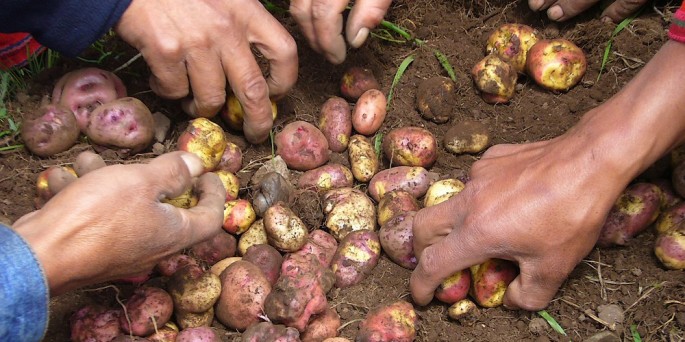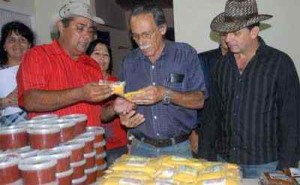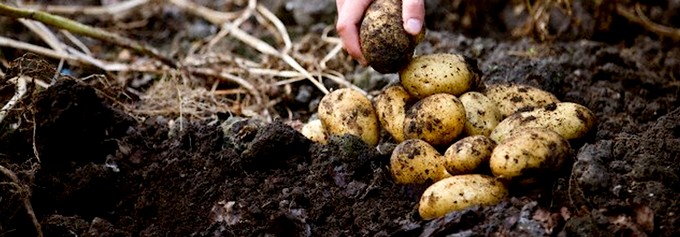
Seeds for the future?
CAMAGÜEY — Through an odd twist of fate, Vladimir now sells potatoes instead of growing them.
“I get more or less the same sunshine riding a bicycle as I did in Sola, but now I earn more and I’m in town,” he says. “The day they stopped growing potatoes in Camagüey they did me a big favor, though I know that for many people it was a costly experience and there are towns that never recovered from the blow.”
For decades, this province saved its best land for the cultivation of potatoes. The prime land covered five municipalities, with the main plantations in the valley of Sierra de Cubitas, in the northern region of the province.
But the Special Period and the Agriculture Ministry’s reshuffles meant an end to the Camagüeyan plantations, which by 1999 averaged 5,300 quintales per caballería [530 tons per 33 acres], one thousand quintales fewer than their counterparts in western Cuba.
“What happened is that they ended all support for potato growing in Camagüey,” says Ignacio, an old driver of irrigation trucks, alluding to the Agriculture Ministry. “They started to complain about the cost, about the seeds — and finally they cut off our supplies at the border with Ciego de Ávila province.”
“I don’t know the logic behind it, but the land in [the cities of] Venezuela and Ceballos [in Ciego de Ávila] is no different from the land in Sola and Esmeralda, not even in terms of climate. The plain and simple reason is that they wanted to cut down expenses and it was our turn to be lopped off.”
A ‘port-side’ agriculture
Cuban agriculture has always lived under a sword of Damocles — its dependence on other countries. Beginning with sugar and tobacco and ending in products as “exotic” as honey, since colonial days, farmers have been constantly affected by the ups and downs of foreign trade.
The limitations of the local market and Cuba’s historic relation with foreign actors (variously Spain, the United States and the socialist bloc) contributed to accentuate that reality, even in factors as essential as seeds.
For example, the largest potato crop in record (372,000 tons in the year 2000) was mostly possible thanks to the importation of seeds from Canada and several European countries at a cost of approximately $20 million — an amount that today would be several times greater.
The so-called queen of Cuban cuisine has become a luxury item, reserved for distribution and sale in Havana, for feeding tourists and for some productions of the food industry.

Unlike the sugar cane, tobacco or greens, crops for which Cuba has developed its own varieties, when it comes to the potato, legumes and grains, the reality is, to various degrees, different.
In fact, a program as prioritized as Urban and Suburban Farming includes among its objectives the creation of a seed farm in each municipality; yet, after three years of effort, only 147 centers of that type operate today.
Their development runs into obstacles as diverse as the lack of resources or insufficient payments to the producers, “who in many cases earn more selling potatoes for consumption than for seeding,” said Adolfo Rodríguez Nodals, the project’s director, some months ago.
To Rodríguez, who is also director of the Institute of Basic Research into Tropical Agriculture (INIFAT), Cuban officials don’t realize the need for certified seeds, “which, with the same amount of work, produce much larger crops.”
Some growers prefer to wait for guidance and resources from the Ministry. And many of them look at the program with skepticism, especially in view of the high cost of seeds, which are marketed by a national company at prices much higher than those paid to the producers.
For example, one gram of tomato seeds is priced at about 2 pesos, a price more expensive than the fruit from which they are obtained.
At first sight, it is a windfall for the Urban Farming project, which has signed contracts with almost 1,000 farmers nationwide, but it ends up being counterproductive for the farm growth being promoted by the State.
Contributions from centers such as the Institute of Research into Tropical Foods (INIVIT), which guarantees the seedlings for those crops, and the high international prices of other farm products have led Havana into concentrating its efforts in the acquisition of seeds for potatoes and legumes, crops that practically monopolize the $11 million set aside for seeds in 2015.
But that dependence puts Cuban agriculture at a disadvantage vis-à-vis other farm industries in the region, such as Colombia and Mexico, which are capable of completing all their productive cycles.
A partial solution might be the importation of seeds from the United States, a possibility defended two weeks ago by Manuel Rodríguez, director of the company that produces and markets seeds in Cuba.

“Our only solution is transgenic cultivation,” Rodríguez said, during a press conference reported by the German news agency DPA. “But we’re open to all contacts, which have increased in recent months,” he added.
The $2 billion that Cuba spends yearly in the purchase of food are the greatest incentive to carry out those negotiations, especially with U.S. suppliers. And the rapprochement between Havana and Washington come at an ideal time for them.
Like swallows in spring, a delegation of U.S. businessmen came to Cuba in March looking for business opportunities. The group included members of the U.S. Agricultural Coalition for Cuba, a bipartisan lobby that is betting on normalizing trade between the two countries.
“We are more optimistic than ever,” said Elizabeth C. Ward, the president of the USA Rice Federation, quoted by Granma. She believes that a decisive factor in the struggle against the restrictions will be the influence of U.S. farmers, who carry great weight in several states and can send a clear message to Congress: It is time to lift the blockade.
The outcome is not definite but the first steps so far point to a promising crop that can improve the economy on both sides of the Florida Straits. Time will tell.



